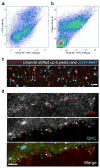Sorting of small infectious virus particles by flow virometry reveals distinct infectivity profiles
- PMID: 25641385
- PMCID: PMC4315362
- DOI: 10.1038/ncomms7022
Sorting of small infectious virus particles by flow virometry reveals distinct infectivity profiles
Abstract
The nature and concentration of lipids and proteins at the surface of viruses are essential parameters for determining particle infectiveness. Historically, averaged bulk analysis of viral particles has been the primary method to quantitatively investigate these parameters, though this neglects heterogeneity within populations. Here we analyse the properties of Junin virus particles using a sensitive flow virometry assay and further sort virions while conserving their infectiveness. This method allows us to characterize the relationship between infectivity, virus size and RNA content and to compare particles secreted by Vero cells with those from physiologically relevant human primary macrophages. Our study highlights significant differences in particle infectivity according to its nature, the type of producer cells and the lipid membrane composition at the budding site. Together, our results present the flow virometry assay as a powerful and versatile tool to define virus particle profiles.
Conflict of interest statement
The authors declare no conflict of interest.
Figures






References
-
- van der Vlist EJ, Nolte-’t Hoen EN, Stoorvogel W, Arkesteijn GJ, Wauben MH. Fluorescent labeling of nano-sized vesicles released by cells and subsequent quantitative and qualitative analysis by high-resolution flow cytometry. Nature protocols. 2012;7:1311–1326. doi: 10.1038/nprot.2012.065. - DOI - PubMed
Publication types
MeSH terms
Grants and funding
LinkOut - more resources
Full Text Sources
Other Literature Sources

